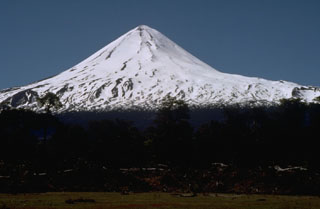Report on Llaima (Chile) — December 1979
Scientific Event Alert Network Bulletin, vol. 4, no. 12 (December 1979)
Managing Editor: David Squires.
Llaima (Chile) Two new explosions; October lava flows described
Please cite this report as:
Global Volcanism Program, 1979. Report on Llaima (Chile) (Squires, D., ed.). Scientific Event Alert Network Bulletin, 4:12. Smithsonian Institution. https://doi.org/10.5479/si.GVP.SEAN197912-357110
Llaima
Chile
38.692°S, 71.729°W; summit elev. 3125 m
All times are local (unless otherwise noted)
H. Moreno and C. Marangunic visited the volcano on 28 October. They found the flow fronts to be composed of fresh lava [debris] and pyroclastic fragments mixed with older material, forming a kind of "lava debris flow" [and pyroclastic flow] that moved rapidly over the ice. The continuous fumarolic activity that followed the eruption was quite intense on the 28th.
Pedro Riffo A. reports that two new explosions from the summit crater took place at 1226 on 24 November. A steam and ash column rose about 2 km. Minor emission of fine dark gray to brownish ash followed the main explosions.
Geological Summary. Llaima, one of Chile's largest and most active volcanoes, contains two main historically active craters, one at the summit and the other, Pichillaima, to the SE. The massive, dominantly basaltic-to-andesitic, stratovolcano has a volume of 400 km3. A Holocene edifice built primarily of accumulated lava flows was constructed over an 8-km-wide caldera that formed about 13,200 years ago, following the eruption of the 24 km3 Curacautín Ignimbrite. More than 40 scoria cones dot the volcano's flanks. Following the end of an explosive stage about 7200 years ago, construction of the present edifice began, characterized by Strombolian, Hawaiian, and infrequent subplinian eruptions. Frequent moderate explosive eruptions with occasional lava flows have been recorded since the 17th century.
Information Contacts: H. Moreno R., Univ. de Chile, Santiago; P. Riffo A., Univ. de Chile, Temuco.

